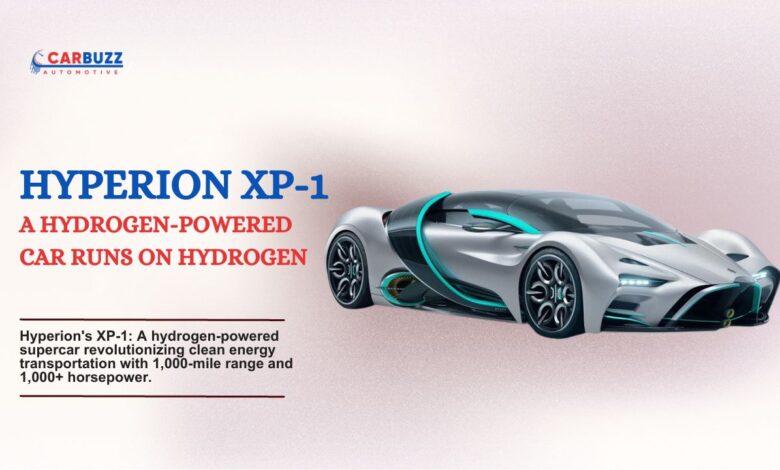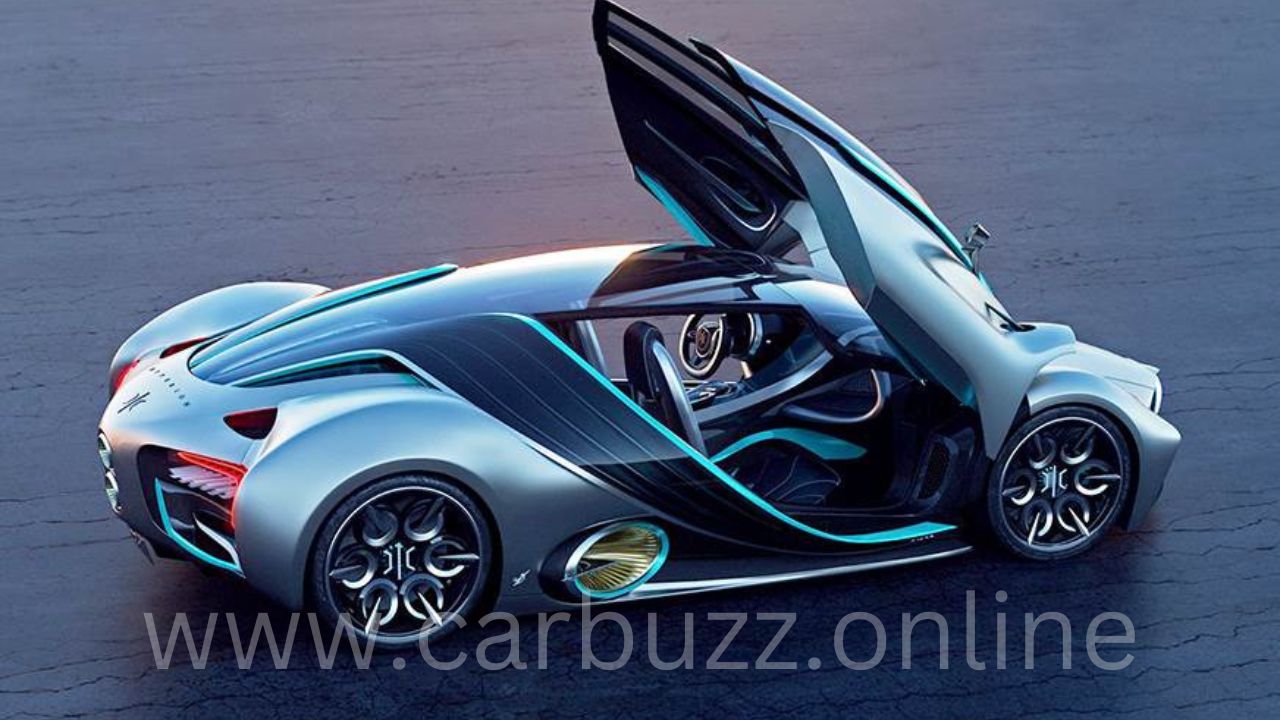Powered by NASA technology, this hypercar runs on hydrogen!

The realm of automobiles is in the midst of a profound transformation fueled by an unwavering commitment to groundbreaking innovation and environmental responsibility. At the forefront of this transformation stands Hyperion, a California-based company that has unveiled the Hyperion XP-1, a hydrogen-powered hypercar poised to revolutionize how we perceive and utilize hydrogen fuel cell technology. In this comprehensive exploration, we delve into the intricacies of the Hyperion XP-1, examining its groundbreaking features, potential impact on the automotive industry, and the unique advantages of hydrogen as a fuel source. Our goal with this article is to offer a comprehensive insight into the paradigm-shifting Hydrogen Revolution embodied by the XP-1.
The Hyperion XP-1: A Glimpse into the Future of Automotive Excellence
Introduction to the Hyperion XP-1:
The Hyperion XP-1 stands as a testament to cutting-edge engineering and sustainability. More than a mere automobile, this hydrogen-powered Hypercar signifies a monumental technological leap forward. Its innovative design and performance capabilities make it a pivotal development in the automotive industry.
Impressive Range and Power:
One of the most remarkable features of the XP-1 is its astonishing driving range. Fueled by compressed hydrogen gas, this exceptional Hypercar boasts a staggering 1,000-mile range on a solitary tank. Such an impressive range sets it apart from its electric counterparts, offering a glimpse into a future of extended travel without compromising on sustainability.
Blazing Speed of Hypercar:
Enthusiasts of velocity will find exhilaration in the fact that the XP-1 can catapult from 0 to 60 miles per hour in a little over two seconds. This exceptional speed is a testament to the power of hydrogen fuel cell technology, which provides instantaneous acceleration and torque.
The Power of Hydrogen Fuel Cells:
To understand the XP-1 fully, diving into the technology under its sleek hood is essential. Hydrogen fuel cells produce energy through the fusion of hydrogen with atmospheric oxygen, resulting in only water as emissions and a constant flow of electricity to drive the vehicle forward. This eco-friendly approach sets the XP-1 apart from traditional combustion engine vehicles.
Unleashing the Potential of Hydrogen as a Fuel Source:
Comparing Hydrogen to Batteries:
The XP-1’s utilization of hydrogen as a fuel source brings several advantages compared to traditional battery-powered electric vehicles. Explore why hydrogen may be the future of clean energy in the automotive world.
Weight Efficiency:
Hydrogen gas, known for its lightness, significantly contributes to the XP-1’s energy efficiency. Its lightweight design reduces overall vehicle weight, resulting in enhanced energy efficiency, enabling it to travel longer distances at faster speeds, all while minimizing environmental impact.
The Race for Hydrogen Dominance:
The Landscape of Hydrogen-Powered Vehicles:
While the XP-1 is a remarkable achievement, it’s part of a larger movement within the automotive industry. Numerous Hypercar manufacturers, including Honda, Toyota, Hyundai, and General Motors, have explored hydrogen fuel cell technology for research purposes and in limited sales. However, none have created a vehicle as exciting as the XP-1 that captures the public’s attention.
The Challenge of Fueling Hydrogen-Powered Cars:
One significant hurdle faced by hydrogen-powered vehicles is the need for more infrastructure. Compared to gasoline or electric charging stations, hydrogen filling stations are sparse in the United States. A Department of Energy map reveals clusters of charging stations around major California cities, with virtually none in the rest of the country. This infrastructure challenge represents a significant barrier to the widespread adoption of hydrogen-powered vehicles.
Hydrogen: The Elemental Advantage:
The Essence of Hydrogen:
To fully grasp the potential of hydrogen as a fuel source, it’s essential to understand its fundamental properties. Hydrogen, the lightest and simplest element on the periodic table, holds tremendous promise due to its abundance in the universe and its unique characteristics.
Efficiency in Refueling:
Hydrogen’s efficiency shines when it comes to refuelling. Unlike electric vehicles that require hours to charge, filling the XP-1’s tank with hydrogen takes a mere three to five minutes. This rapid refuelling capability offers convenience and makes hydrogen-powered vehicles suitable for long-distance travel.
Durability of Hydrogen Gas:
Moreover, hydrogen gas proves to be durable, particularly when fast-charged. Unlike traditional batteries that degrade over time with frequent fast charging, hydrogen fuel cells maintain their performance. To enhance durability and lifespan, the XP-1 integrates a compact battery as a reservoir for storing electricity generated by the fuel cell, mitigating wear and tear.
Hyperion’s Vision for a Hydrogen-Fueled Future:
Hyperion’s Mission:
Beyond the XP-1’s exceptional performance and innovative technology, Hyperion has a broader mission – to generate interest in hydrogen power. The company’s CEO envisions a future where hydrogen plays a pivotal role in clean energy, and the XP-1 symbolizes this vision.
Operational Prototypes and Production Plans:
Hyperion has made significant strides in realizing its vision. The company already has operational prototype Hypercars and aims to deliver the first production vehicles to customers by the end of the next year. While pricing details remain undisclosed, it is clear that the XP-1’s high-performing versions, capable of producing 1,000 horsepower, may reach the million-dollar range. The company is capping production at 300 units.
Expanding Horizons:
Hyperion’s ambitions extend beyond the XP-1. The company aims to manufacture more practical hydrogen-fueled Hypercars accessible to a broader customer base. Additionally, Hyperion collaborates with NASA to commercialize various hydrogen technologies the space agency uses and to develop new applications for hydrogen.
NASA Collaboration:
Notably, Hyperion has agreements to license a range of NASA technologies, a testament to its commitment to advancing hydrogen technology for vehicles and other applications. This collaboration aims to instil a sense of pride in American innovation. It showcases the potential of hydrogen as an energy medium.
Conclusion:
In conclusion, the Hyperion XP-1 is more than just a Hypercar; it symbolizes innovation and sustainability. Its exceptional range, blazing speed, and the promise of hydrogen as a clean energy source challenge the conventions of the automotive industry. However, it’s not just about the car itself; it’s about a future where innovation and environmental consciousness go hand in hand.
In navigating the ever-changing transportation frontier, embracing the immense potential of hydrogen-based propulsion wholeheartedly becomes imperative. The Hyperion XP-1 leads the way, inspiring us to look beyond traditional norms and towards a future where innovation, performance, and sustainability converge seamlessly.





